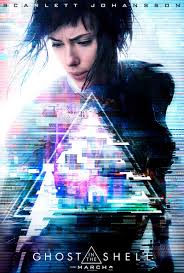Ghost in the Shell
Posted on March 30, 2017 at 11:11 pm

Oh, I don’t know. Maybe if you are a long-time fan of the “Ghost in the Shell” mange by Masamune Shirow and anime and are yet still not offended at the casting of a white actress in a Japanese story you might enjoy seeing a big-budget version of the story with very high-end design and special effects. I am new to the franchise and I was bored. Like a lot of video game movies, it loses the story and characters in a barrage of visual effects and shoot-outs.
Scarlett Johansson plays Major, who used to be a person but is now robot with a human brain or a human brain with a robot body. People do a lot of explaining in this movie, but never about the stuff we would like to have explained. So one character tells us that Major is not a machine but a weapon in the fight against cyber-terrorism. But we never find out why Major’s clothes keep disappearing when she goes into battle. Or why a robot breathes and cries.
In an early scene, we see businessmen at an expensive dinner, being served by elegant but not un-sexy robot geishas. I hope you have seen enough movies to know that when one of them arrogant insists that “There is nothing I can’t do, nothing I can’t know, nothing I can’t be,” he is not going to be around much longer. Some gunmen break in and start shooting, and Major arrives to fight them.
Major was once a human woman. When she was injured in the terrorist attack that killed her parents, her body could not be saved but in a pioneering experiment by Dr. Ouelet (Juliette Binoche), she is turned into a cyborg. At least that is the story she has been told. She has flashes of what could be memories but it seems to her as though there is thick fog over her memories “and I can’t see through it.” Dr. Ouelet is very proud of Major, almost maternal. And Major has a partner, Batou (Pilou Asbæk). Where she is a robot with a human brain, he is a human with mechanical parts.
The man/robot/operating system/entity behind the attack is cerebral hacking and killing more people as Major is experiencing what she calls “glitches,” especially after she does a risky “deep dive” into the network of the hacked geisha robot. But are they glitches or “Total Recall”/”Bourne”-style flashes of memory?
When the comic first appeared, some of these issues were cutting edge but they have been so thoroughly hashed out in so many movies (and in real life) that most of it is as outdated as a VHS video of “WarGames.” The issue of consent is more timely, as Major has to affirmatively accept various risks and procedures (like all of those “I agree” boxes you have to check every time you update your software), but the movie is too busy showing us zippy Pokemon Go-style virtual ads all over the city to spend any thought on it, or anything else, for that matter. It is a shame that a movie about the spark of human consciousness that remains inside a machine is itself a machine without any evidence of humanity at all.
Parents should know that this film has constant sci-fi/action style peril and violence, guns, explosions, fire, terrorism, a suicide, murder, with characters injured and killed, and some graphic and disturbing images, some nudity, prostitutes and sexual predator, smoking, and drinking. There has been some controversy over the casting of non-Asian actors. Scarlett Johansson responded “I certainly would never presume to play another race of a person. Diversity is important in Hollywood, and I would never want to feel like I was playing a character that was offensive. Also, having a franchise with a female protagonist driving it is such a rare opportunity. Certainly, I feel the enormous pressure of that—the weight of such a big property on my shoulders.” The director of the anime version also supports Johansson in the role: “What issue could there possibly be with casting her? The Major is a cyborg and her physical form is an entirely assumed one. The name ‘Motoko Kusanagi’ and her current body are not her original name and body, so there is no basis for saying that an Asian actress must portray her.” On Slate, Aisha Harris explains why a revelation late in the film is especially troubling in the movie’s portrayal of race.
Family discussion: Is Major a person, a machine, or a weapon? What enhancement would you like to have?
If you like this, try: the “Matrix” and “Bourne” series, “Lucy,” and the Ghost in the Shell comics and anime
